-
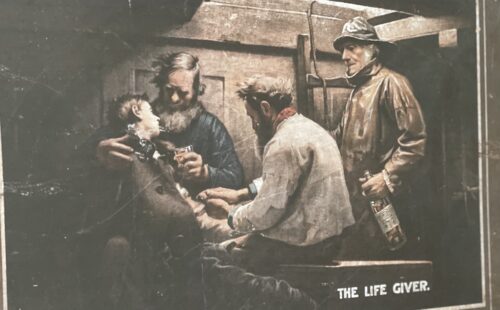
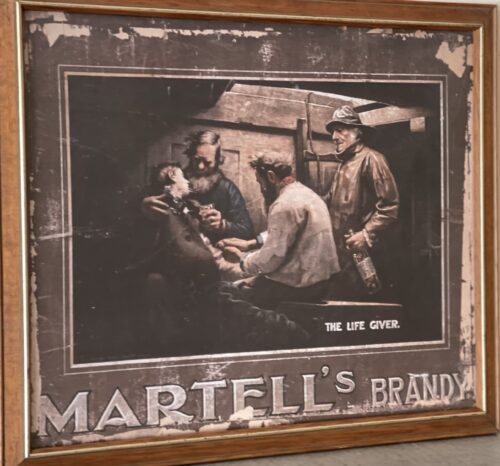 40cm x 34cm Limerick Martell is a Cognac house founded in 1715 by Jean Martell (1694–1753). It is part of the Martell Mumm Perrier-Jouët subsidiary of the French wines and spirits conglomerate Pernod Ricard. In 1715, Jean Martell, a young merchant originally from Jersey, created his own trading business at Gatebourse in Cognac, on the banks of the Charente, and thus founded one of the first cognac houses. Martell used grapes from the vineyards in the Borderie subregion, and used Tronçais oak for its casks, this made a combination that resulted in an exceptionally smooth cognac.After his death in 1753, his widow and then his two sons and grandson continued this tradition and developed the export business to make Martell the number one in England in 1814. In 1831, Martell created his first "VSOP" (Very Superior Old Pale) cognac and continued its international expansion. Its fame spread throughout the world, with the first exports to Japan and other Asian markets, such as Indonesia, Vietnam, Malaysia and Korea. On the coat of arms are what appear to be three small martels or war hammers, but could also be keg mallets. Cordon Bleu, created in 1912, is certainly the company’s most famous product. Martell was served aboard the Queen Mary in 1936 and even on Concorde in 1977. In 1987, Seagram took control of the French manufacturer for $1.2 billion. Since the acquisition of some of the Seagram Group’s spirits in 2001, Martell has belonged to the French spirits group, Pernod Ricard. In the 2000s, Martell created new cognacs: "Martell XO" in 2005, "Martell Création Grand Extra" in 2007, in a bottle designed by the artist and glass designer Serge Mansau. In 2009, Martell cognac launched its signature cognac, "L'Or de Jean Martell". In 2011, Martell expanded its "ultra-prestige" range with an exceptional cognac, "Martell Chanteloup Perspective", a tribute to the know-how of the cellar masters and to the Domaine de Chanteloup. In 2006, Martell joined the Comité Colbert, an association that promotes French luxury houses on an international scale. In 2010, Martell renewed its sponsorship with the Palace of Versailles, which began in 2007, by supporting the restoration of the Queen’s antechamber. In 2012, Martell Cordon Bleu, which was launched by Edouard Martell in 1912 at the Hotel de Paris in Monaco, celebrated its 100th birthday in the same place.
40cm x 34cm Limerick Martell is a Cognac house founded in 1715 by Jean Martell (1694–1753). It is part of the Martell Mumm Perrier-Jouët subsidiary of the French wines and spirits conglomerate Pernod Ricard. In 1715, Jean Martell, a young merchant originally from Jersey, created his own trading business at Gatebourse in Cognac, on the banks of the Charente, and thus founded one of the first cognac houses. Martell used grapes from the vineyards in the Borderie subregion, and used Tronçais oak for its casks, this made a combination that resulted in an exceptionally smooth cognac.After his death in 1753, his widow and then his two sons and grandson continued this tradition and developed the export business to make Martell the number one in England in 1814. In 1831, Martell created his first "VSOP" (Very Superior Old Pale) cognac and continued its international expansion. Its fame spread throughout the world, with the first exports to Japan and other Asian markets, such as Indonesia, Vietnam, Malaysia and Korea. On the coat of arms are what appear to be three small martels or war hammers, but could also be keg mallets. Cordon Bleu, created in 1912, is certainly the company’s most famous product. Martell was served aboard the Queen Mary in 1936 and even on Concorde in 1977. In 1987, Seagram took control of the French manufacturer for $1.2 billion. Since the acquisition of some of the Seagram Group’s spirits in 2001, Martell has belonged to the French spirits group, Pernod Ricard. In the 2000s, Martell created new cognacs: "Martell XO" in 2005, "Martell Création Grand Extra" in 2007, in a bottle designed by the artist and glass designer Serge Mansau. In 2009, Martell cognac launched its signature cognac, "L'Or de Jean Martell". In 2011, Martell expanded its "ultra-prestige" range with an exceptional cognac, "Martell Chanteloup Perspective", a tribute to the know-how of the cellar masters and to the Domaine de Chanteloup. In 2006, Martell joined the Comité Colbert, an association that promotes French luxury houses on an international scale. In 2010, Martell renewed its sponsorship with the Palace of Versailles, which began in 2007, by supporting the restoration of the Queen’s antechamber. In 2012, Martell Cordon Bleu, which was launched by Edouard Martell in 1912 at the Hotel de Paris in Monaco, celebrated its 100th birthday in the same place. -
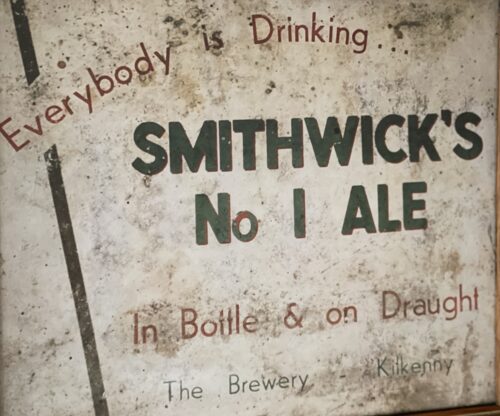
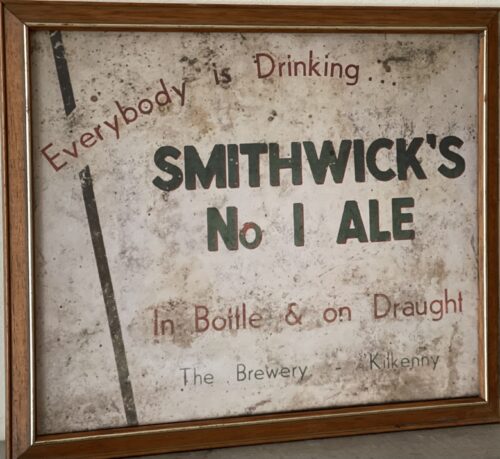 40cm x 34cm LimerickThe old Smithwicks brewery is on the site of a Franciscan abbey, where monks had brewed ale since the 14th century, and ruins of the original abbey still remain on its grounds. The old brewery has since been renovated and now hosts "The Smithwick's Experience Kilkenny" visitor attraction and centre.At the time of its closure, it was Ireland's oldest operating brewery. John Smithwick was an orphan who had settled in Kilkenny. Shortly after his arrival, Smithwick went into the brewing business with Richard Cole on a piece of land that Cole had leased from the Duke of Ormond in 1705. Five years later, John Smithwick became the owner of the land. The brewery stayed small, servicing a loyal local following while John Smithwick diversified. Following John Smithwick's death, the brewery temporarily fell out of family hands. John Smithwick's great grandson, Edmond bought the brewery land back freehold and worked to reshape its future. Edmond concentrated on discovering new markets and successfully building export trade. Drinkers in England, Scotland and Wales developed a taste for Smithwick's brews and output increased fivefold. As a result of substantial contributions made to St Mary's Cathedral, Edmond became great friends with Irish liberal Daniel O'Connell, who later became godfather to one of his sons. Edmond Smithwick became well known and respected by the people of Kilkenny who elected him town mayor four times. In 1800, export sales began to fall and the brewing industry encountered difficulty. To combat this, the Smithwick family increased production in their maltings, began selling mineral water and delivered butter with the ale from the back of their drays.By 1900, output was at an all-time low and the then owner James Smithwick was advised by auditors to shut the doors of the brewery. Instead, James reduced the range of beers they produced and set out to find new markets. He secured military contracts and soon after saw output increase again. James' son, Walter, took control in 1930 and steered the brewery to success through the hardships of both World War II and increasingly challenging weather conditions.By January 1950, Smithwick's was exporting ale to Boston.Smithwick's was purchased from Walter Smithwick in 1965 by Guinness and is now, along with Guinness, part of Diageo. Together, Guinness & Co. and Smithwick's developed and launched Smithwick's Draught Ale in 1966. By 1979, half a million barrels were sold each year.In 1980, Smithwick's began exporting to France. In 1993, Smithwick's Draught became Canada's leading imported ale.By 2010, Smithwick's continued to be brewed in Dundalk and Kilkenny with tankers sent to Dublin to be kegged for the on trade market. Cans and bottles were packaged by IBC in Belfast.Production in the Kilkenny brewery finished on 31 December 2013 and Smithwicks brands are now produced in the Diageo St.James' Gate brewery in Dublin.The original Kilkenny site was sold to Kilkenny County Council, with a small portion of the site dedicated to the opening of a visitor's centre, the "Smithwick's Experience Kilkenny".
40cm x 34cm LimerickThe old Smithwicks brewery is on the site of a Franciscan abbey, where monks had brewed ale since the 14th century, and ruins of the original abbey still remain on its grounds. The old brewery has since been renovated and now hosts "The Smithwick's Experience Kilkenny" visitor attraction and centre.At the time of its closure, it was Ireland's oldest operating brewery. John Smithwick was an orphan who had settled in Kilkenny. Shortly after his arrival, Smithwick went into the brewing business with Richard Cole on a piece of land that Cole had leased from the Duke of Ormond in 1705. Five years later, John Smithwick became the owner of the land. The brewery stayed small, servicing a loyal local following while John Smithwick diversified. Following John Smithwick's death, the brewery temporarily fell out of family hands. John Smithwick's great grandson, Edmond bought the brewery land back freehold and worked to reshape its future. Edmond concentrated on discovering new markets and successfully building export trade. Drinkers in England, Scotland and Wales developed a taste for Smithwick's brews and output increased fivefold. As a result of substantial contributions made to St Mary's Cathedral, Edmond became great friends with Irish liberal Daniel O'Connell, who later became godfather to one of his sons. Edmond Smithwick became well known and respected by the people of Kilkenny who elected him town mayor four times. In 1800, export sales began to fall and the brewing industry encountered difficulty. To combat this, the Smithwick family increased production in their maltings, began selling mineral water and delivered butter with the ale from the back of their drays.By 1900, output was at an all-time low and the then owner James Smithwick was advised by auditors to shut the doors of the brewery. Instead, James reduced the range of beers they produced and set out to find new markets. He secured military contracts and soon after saw output increase again. James' son, Walter, took control in 1930 and steered the brewery to success through the hardships of both World War II and increasingly challenging weather conditions.By January 1950, Smithwick's was exporting ale to Boston.Smithwick's was purchased from Walter Smithwick in 1965 by Guinness and is now, along with Guinness, part of Diageo. Together, Guinness & Co. and Smithwick's developed and launched Smithwick's Draught Ale in 1966. By 1979, half a million barrels were sold each year.In 1980, Smithwick's began exporting to France. In 1993, Smithwick's Draught became Canada's leading imported ale.By 2010, Smithwick's continued to be brewed in Dundalk and Kilkenny with tankers sent to Dublin to be kegged for the on trade market. Cans and bottles were packaged by IBC in Belfast.Production in the Kilkenny brewery finished on 31 December 2013 and Smithwicks brands are now produced in the Diageo St.James' Gate brewery in Dublin.The original Kilkenny site was sold to Kilkenny County Council, with a small portion of the site dedicated to the opening of a visitor's centre, the "Smithwick's Experience Kilkenny". -
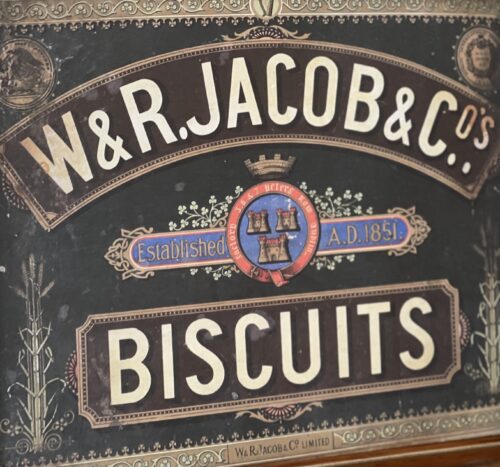
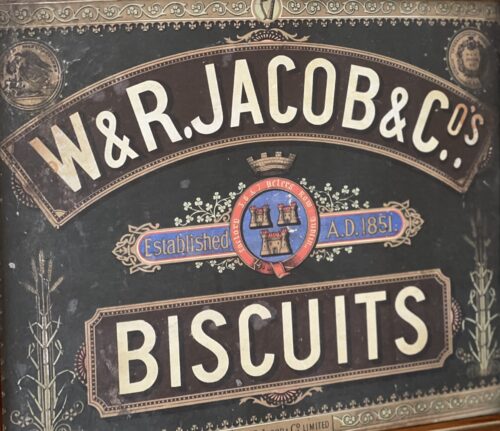 40cm x 34cm LimerickThe biscuit making firm of W. & R. Jacob's were one the largest employers in the Dublin of 1916, and their factory was seized on Easter Monday by perhaps 100 members of the 2nd Battalion of the Dublin Brigade of the Irish Volunteers under Thomas MacDonagh. The factory itself was an enormous and formidable Victorian edifice located on the 'block' enclosed by Bishop St, Bride St, Peter's St and Peter's Row, and between St Patrick's Cathedral and St Stephen's Green. Its seizure helped to complete a loop of building cross the south inner city; the factory had two large towers that could act as observation points, while its location was very close to both Camden St and Patrick St: natural routeways for troops entering the city centre from Portobello Barracks in Rathmines and Wellington Barracks on the South Circular Road. There were only a few staff present in the building when the Volunteers broke into it; a number of smaller outposts were established in the area around the factory. While the garrison saw some fighting early in the week, their principal enemies proved to be boredom and the locals: the factory was surrounded by tenements, and the Volunteers were attacked and abused by residents, many of whom were Jacob's workers themselves. The families of servicemen were also quite hostile, but there may have been another reason for this hostility: Michael O'Hanrahan, who was in Jacob's, expressed his concern that the choice of location might endanger local residents if the British chose to attack. As it happens, the factory was largely by-passed, though it was fired upon intermittently throughout the week by troops in Dublin Castle and elsewhere. MacDonagh surrendered in nearby St Patrick's Park on Sunday 30 April; some of the factory was looted after the Volunteers had left. Three members of the Jacob's garrison were executed. Most of the factory was eventually demolished, though fragments of the ground storey and one of the towers are still visible on Bishop St between the DIT campus on Aungier St and the National Archives of Ireland.
40cm x 34cm LimerickThe biscuit making firm of W. & R. Jacob's were one the largest employers in the Dublin of 1916, and their factory was seized on Easter Monday by perhaps 100 members of the 2nd Battalion of the Dublin Brigade of the Irish Volunteers under Thomas MacDonagh. The factory itself was an enormous and formidable Victorian edifice located on the 'block' enclosed by Bishop St, Bride St, Peter's St and Peter's Row, and between St Patrick's Cathedral and St Stephen's Green. Its seizure helped to complete a loop of building cross the south inner city; the factory had two large towers that could act as observation points, while its location was very close to both Camden St and Patrick St: natural routeways for troops entering the city centre from Portobello Barracks in Rathmines and Wellington Barracks on the South Circular Road. There were only a few staff present in the building when the Volunteers broke into it; a number of smaller outposts were established in the area around the factory. While the garrison saw some fighting early in the week, their principal enemies proved to be boredom and the locals: the factory was surrounded by tenements, and the Volunteers were attacked and abused by residents, many of whom were Jacob's workers themselves. The families of servicemen were also quite hostile, but there may have been another reason for this hostility: Michael O'Hanrahan, who was in Jacob's, expressed his concern that the choice of location might endanger local residents if the British chose to attack. As it happens, the factory was largely by-passed, though it was fired upon intermittently throughout the week by troops in Dublin Castle and elsewhere. MacDonagh surrendered in nearby St Patrick's Park on Sunday 30 April; some of the factory was looted after the Volunteers had left. Three members of the Jacob's garrison were executed. Most of the factory was eventually demolished, though fragments of the ground storey and one of the towers are still visible on Bishop St between the DIT campus on Aungier St and the National Archives of Ireland. -

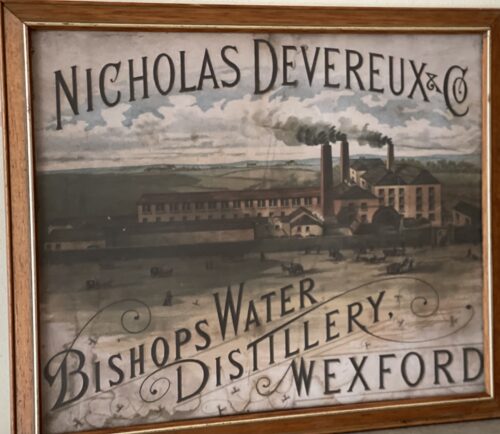 40cm x 34cm LimerickBishops Water Distillery(subsequently known as Nicholas Devereux Finest Irish Whisky) was an Irish whiskey distillery which operated in Wexford, Ireland between 1827 and 1914. The distillery was named for a stream which ran along the back of the distillery, the Bishop's Water, said to possess "various occult properties derived from the blessings of the sainted Bishop of Ferns". Constructed at a cost of £30,000, the distillery was reported to be “reckoned the most perfect and complete of the kind in Ireland”.In 1833, just a few years after it opened, the distillery recorded an output of about 200,000 gallons per annum .However, output had fallen to just 110,000 gallons per annum in 1886, when the distillery was visited by Alfred Barnard, as recorded in his seminal 1887 publication "The Whisky Distilleries of the United Kingdom". This was amongst the lowest output of any distillery operating in Ireland at the time, and far below the potential output of 250,000 gallons per annum reported when the distillery was offered for sale as a going concern in 1909. The distillery's whiskey, Barnard noted, was highly appreciated locally, and in the British cities where it was exported. In the early 20th century, with the Irish whiskey industry in decline, Bishop's Water distillery, like the majority of distilleries in Ireland at the time, suffered serious financial difficulties, and entered bankruptcy. Following its closure, the distillery was initially converted into an iron works (Pierce Ironworks). However, much of the site was later demolished, and little evidence of the distillery still remains. Some mementos can still be found in locals pubs, while a stone archway known to have been extant in 1903 and now bearing the inscription "Casa Rio", possibly in reference to the location of a Pierce ironworks office in Buenos Aires, marks the entrance to the site where the distillery once stood, on Distillery Road. In 1827, a whiskey distillery was established on what is now Distillery Road, Wexford by a consortium of businessmen. The consortium which traded under "Devereux, Harvey, and Co., Distillers", comprised a number of local businessmen, including Nicholas Devereux, his father John Devereux, and Maurice Crosbie Harvey. John Devereux had previously operated a small distillery in the area in the late 1700s, but will little success. In 1830, one of the partners, Maurice Harvey, was accidentally killed at the distillery by an excise man who was taking aim at some birds flying overhead. A few years later, in 1836, the partnership was dissolved at the mutual consent of the remaining partners, with Nicholas Devereux taking sole ownership of the distillery, after which the distillery traded under the name Nicholas Devereux & Son.On his death in 1840, operation of the distillery was taken over by his son Richard. Nichloas Devereux's granddaughter, Mary Anne Therese was also deeply involving in the distilling industry. She married John Locke, founder of the larger Kilbeggan distillery, and successfully took over the business operations of the distillery on his death in 1868. According to Alfred Barnard, the British journalist who visited Bishop's Water in the 1880s, the distillery produced triple-distilled "old pot still whiskey", which was sold locally in Ireland, and also exported to London, Liverpool, and Bristol. At the time of his visit, the Malt Warehouses on-site contained over 16,000 barrels of pure malt. In addition, upwards of 3,000 casks of whiskey were undergoing maturation at the distillery. Whiskey from the distillery is also noted to have been used in the production of blended whiskeys in later years. In the early 20th century, the distillery suffered financial difficulties. In 1907, an attempt was made to appoint a receiver, and in 1909, the distillery was put up for sale, but no takers could be found.In 1914, distilling eventually ceased at the site, and the remaining stocks were sold off.
40cm x 34cm LimerickBishops Water Distillery(subsequently known as Nicholas Devereux Finest Irish Whisky) was an Irish whiskey distillery which operated in Wexford, Ireland between 1827 and 1914. The distillery was named for a stream which ran along the back of the distillery, the Bishop's Water, said to possess "various occult properties derived from the blessings of the sainted Bishop of Ferns". Constructed at a cost of £30,000, the distillery was reported to be “reckoned the most perfect and complete of the kind in Ireland”.In 1833, just a few years after it opened, the distillery recorded an output of about 200,000 gallons per annum .However, output had fallen to just 110,000 gallons per annum in 1886, when the distillery was visited by Alfred Barnard, as recorded in his seminal 1887 publication "The Whisky Distilleries of the United Kingdom". This was amongst the lowest output of any distillery operating in Ireland at the time, and far below the potential output of 250,000 gallons per annum reported when the distillery was offered for sale as a going concern in 1909. The distillery's whiskey, Barnard noted, was highly appreciated locally, and in the British cities where it was exported. In the early 20th century, with the Irish whiskey industry in decline, Bishop's Water distillery, like the majority of distilleries in Ireland at the time, suffered serious financial difficulties, and entered bankruptcy. Following its closure, the distillery was initially converted into an iron works (Pierce Ironworks). However, much of the site was later demolished, and little evidence of the distillery still remains. Some mementos can still be found in locals pubs, while a stone archway known to have been extant in 1903 and now bearing the inscription "Casa Rio", possibly in reference to the location of a Pierce ironworks office in Buenos Aires, marks the entrance to the site where the distillery once stood, on Distillery Road. In 1827, a whiskey distillery was established on what is now Distillery Road, Wexford by a consortium of businessmen. The consortium which traded under "Devereux, Harvey, and Co., Distillers", comprised a number of local businessmen, including Nicholas Devereux, his father John Devereux, and Maurice Crosbie Harvey. John Devereux had previously operated a small distillery in the area in the late 1700s, but will little success. In 1830, one of the partners, Maurice Harvey, was accidentally killed at the distillery by an excise man who was taking aim at some birds flying overhead. A few years later, in 1836, the partnership was dissolved at the mutual consent of the remaining partners, with Nicholas Devereux taking sole ownership of the distillery, after which the distillery traded under the name Nicholas Devereux & Son.On his death in 1840, operation of the distillery was taken over by his son Richard. Nichloas Devereux's granddaughter, Mary Anne Therese was also deeply involving in the distilling industry. She married John Locke, founder of the larger Kilbeggan distillery, and successfully took over the business operations of the distillery on his death in 1868. According to Alfred Barnard, the British journalist who visited Bishop's Water in the 1880s, the distillery produced triple-distilled "old pot still whiskey", which was sold locally in Ireland, and also exported to London, Liverpool, and Bristol. At the time of his visit, the Malt Warehouses on-site contained over 16,000 barrels of pure malt. In addition, upwards of 3,000 casks of whiskey were undergoing maturation at the distillery. Whiskey from the distillery is also noted to have been used in the production of blended whiskeys in later years. In the early 20th century, the distillery suffered financial difficulties. In 1907, an attempt was made to appoint a receiver, and in 1909, the distillery was put up for sale, but no takers could be found.In 1914, distilling eventually ceased at the site, and the remaining stocks were sold off. -
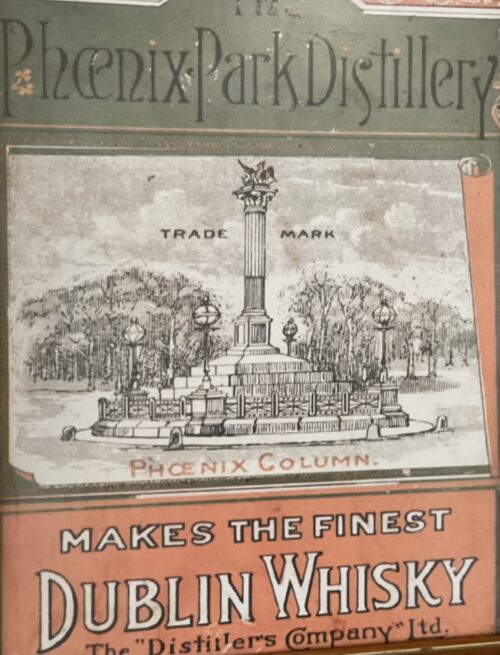
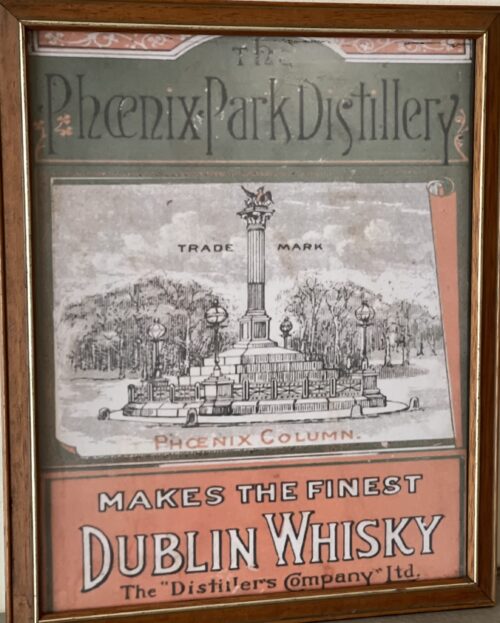 40cm x 34cm Limerick
40cm x 34cm LimerickThe Distillery in Chapelizod, near Dublin's Phoenix Park, was converted from an old mill in 1878 by the Distillers' Company, Ltd., of Scotland, who later went on to become the biggest player in Scotch Whisky owning brands such as Haig, Dewar's, and Buchanan's, as well as countless Malt and Grain Distilleries in Scotland, until the group was taken over by Guinness in the 1980s.
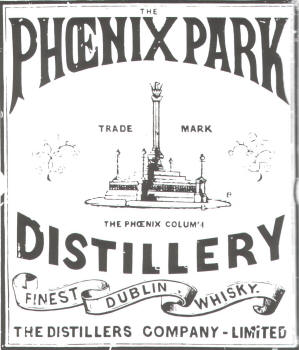 Old Advertisement for Phoenix Park Distillery
Old Advertisement for Phoenix Park DistilleryIt seemed profitable to own an Irish Distillery in those days: Dublin Whiskey, being considered the finest in the world, was priced 25 per cent higher than comparable Scotch Whisky.
The production of Phoenix Park Distillery, 350,000 gallons (1.5 Million Litres) per year, was sold to England and its colonies, as well as used for blending with DCL's own Scottish Malt and Grain Whiskies.
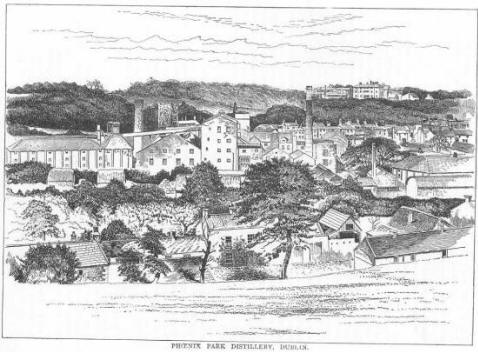 DCL's Phoenix Park Distillery in 1886
DCL's Phoenix Park Distillery in 1886However, Phoenix Park Distillery had only a short life span. Production ceased in 1921, and DCL abandoned the plant a few years later, due to the politically and commercially difficult situation in Ireland at the time.
Today, most buildings have survived, including the mill lade, once holding the largest water wheel in the UK. Others have been converted into apartment houses.
-

 40cm x 34cm LimerickJames Pierce was born in Kilmore in 1813. His father had a forge in the village where he learned his ironwork skills. In 1839 James opened a small foundry specialising in making ‘fire fans’ in Allen Street, Wexford at the age of 26. Eight years later in 1847, he moved to the site previously occupied by the Folly Corn Mill at the junction of Distillery Road and Mill Road. Here he established the ‘Folly Mills Iron Works and Agricultural Machinery and Implement Factory’ (later known as the Mill Road Iron Works). In 1856 James was contracted to build a new bridge over the Slaney linking Carcur and Crosstown to replace the old 1795 Wexford Bridge linking the town and Ferrybank. The bridge was over a quarter of a mile long and remained in use for almost 100 years until 1959 when the new Wexford Bridge was built. The Folly Mills Iron Works also forged the elaborately designed iron railings and gates for the twin churches, completed in 1858. He also built the cast-iron conservatories at Castlebridge House and Edermine House (for Sir James Power of the Power Whiskey family). Pierce’s Foundry was further developed when James’s son Philip (d.1895) joined his father to run the firm. They worked together for just two years until James died in 1868. His other sons Martin (d.1907) and John (d.1926) also joined the business and Pierce’s became the largest agricultural machinery manufacturer in the country with a workforce of 1,000 by 1914. They had offices at Rue de Flandre in Paris and in Rio de Janeiro and their products were shipped all over the world. Two other foundries opened in Wexford at either end of the town. The Star Iron Works was established on reclaimed land off Trinity Street and close to the south railway station. Selskar Iron Works was set up also on reclaimed land opposite the north railway station (the site is now occupied by Dunnes Stores). However, commercial success was interrupted in August 1911 during the infamous ‘Lock-Out’ when the Pierces sought to prevent workers from joining the ITGWU. Soon all of the foundries in the town had followed suit leading to a series of pickets and protests which were not resolved until February of the following year. Pierce’s were exporting horse-drawn farm machinery to Africa and North and South America, Australia and across Europe up until the 1920s. They had offices in Paris and Buenos Aires. In the early 1900s Pierce Bicycle Works operated on the site of the earlier Bishopswater Distillery for about 10 years but without great success. When the old distillery was demolished in the 1940s Pierce’s built housing for employees along the street front (Alvina Brook, 1946). They also built houses for senior managers overlooking the foundry at Avenue de Flandre, Mulgannon Road (1939) and at Casa Rio, Distillery Road (1947) for middle management. Park House (originally Ballyboggan House, built c.1780) was the Pierce family home in the north of the town. However, as the use of tractors became more common, Pierce’s failed to modernise and continued to manufacture for the ‘horse era’. The business inevitably declined and in 1964 the Pierce family sold the business. Pierce Engineering’s last owners, Waterford Stanley, closed the plant in 2002 with the loss of 62 jobs. The site was sold to Tesco who opened their supermarket in 2007. The enormous Pierce’s Foundry site
40cm x 34cm LimerickJames Pierce was born in Kilmore in 1813. His father had a forge in the village where he learned his ironwork skills. In 1839 James opened a small foundry specialising in making ‘fire fans’ in Allen Street, Wexford at the age of 26. Eight years later in 1847, he moved to the site previously occupied by the Folly Corn Mill at the junction of Distillery Road and Mill Road. Here he established the ‘Folly Mills Iron Works and Agricultural Machinery and Implement Factory’ (later known as the Mill Road Iron Works). In 1856 James was contracted to build a new bridge over the Slaney linking Carcur and Crosstown to replace the old 1795 Wexford Bridge linking the town and Ferrybank. The bridge was over a quarter of a mile long and remained in use for almost 100 years until 1959 when the new Wexford Bridge was built. The Folly Mills Iron Works also forged the elaborately designed iron railings and gates for the twin churches, completed in 1858. He also built the cast-iron conservatories at Castlebridge House and Edermine House (for Sir James Power of the Power Whiskey family). Pierce’s Foundry was further developed when James’s son Philip (d.1895) joined his father to run the firm. They worked together for just two years until James died in 1868. His other sons Martin (d.1907) and John (d.1926) also joined the business and Pierce’s became the largest agricultural machinery manufacturer in the country with a workforce of 1,000 by 1914. They had offices at Rue de Flandre in Paris and in Rio de Janeiro and their products were shipped all over the world. Two other foundries opened in Wexford at either end of the town. The Star Iron Works was established on reclaimed land off Trinity Street and close to the south railway station. Selskar Iron Works was set up also on reclaimed land opposite the north railway station (the site is now occupied by Dunnes Stores). However, commercial success was interrupted in August 1911 during the infamous ‘Lock-Out’ when the Pierces sought to prevent workers from joining the ITGWU. Soon all of the foundries in the town had followed suit leading to a series of pickets and protests which were not resolved until February of the following year. Pierce’s were exporting horse-drawn farm machinery to Africa and North and South America, Australia and across Europe up until the 1920s. They had offices in Paris and Buenos Aires. In the early 1900s Pierce Bicycle Works operated on the site of the earlier Bishopswater Distillery for about 10 years but without great success. When the old distillery was demolished in the 1940s Pierce’s built housing for employees along the street front (Alvina Brook, 1946). They also built houses for senior managers overlooking the foundry at Avenue de Flandre, Mulgannon Road (1939) and at Casa Rio, Distillery Road (1947) for middle management. Park House (originally Ballyboggan House, built c.1780) was the Pierce family home in the north of the town. However, as the use of tractors became more common, Pierce’s failed to modernise and continued to manufacture for the ‘horse era’. The business inevitably declined and in 1964 the Pierce family sold the business. Pierce Engineering’s last owners, Waterford Stanley, closed the plant in 2002 with the loss of 62 jobs. The site was sold to Tesco who opened their supermarket in 2007. The enormous Pierce’s Foundry site -
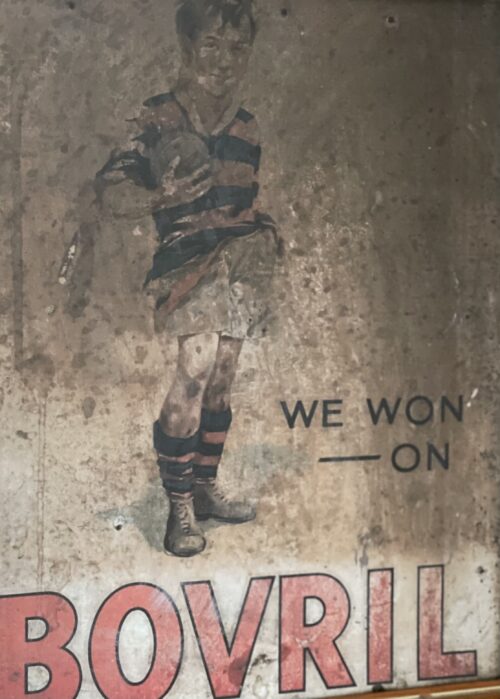
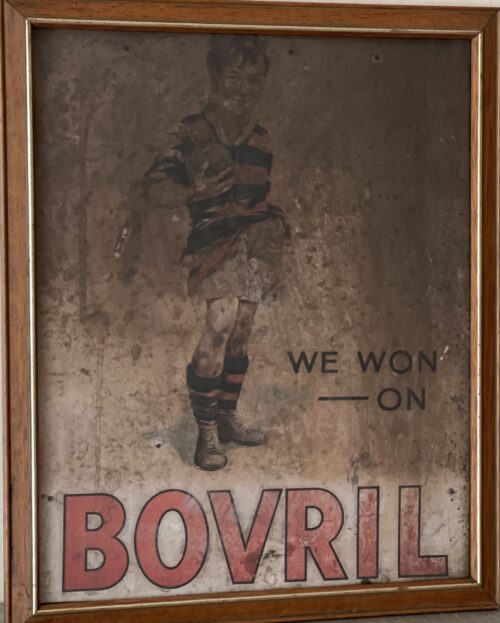 40cm x 34cm LimerickBovril is the trademarked name of a thick and salty meat extract paste similar to a yeast extract, developed in the 1870s by John Lawson Johnston. It is sold in a distinctive bulbous jar, and as cubes and granules. Bovril is owned and distributed by Unilever UK. Its appearance is similar to Marmite and Vegemite. Bovril can be made into a drink ("beef tea") by diluting with hot water or, less commonly, with milk.It can be used as a flavouring for soups, broth, stews or porridge, or as a spread, especially on toast in a similar fashion to Marmite and Vegemite. The first part of the product's name comes from Latin bovīnus, meaning "ox".Johnston took the -vril suffix from Edward Bulwer-Lytton's then-popular novel, The Coming Race (1870), the plot of which revolves around a superior race of people, the Vril-ya, who derive their powers from an electromagnetic substance named "Vril". Therefore, Bovril indicates great strength obtained from an ox.
40cm x 34cm LimerickBovril is the trademarked name of a thick and salty meat extract paste similar to a yeast extract, developed in the 1870s by John Lawson Johnston. It is sold in a distinctive bulbous jar, and as cubes and granules. Bovril is owned and distributed by Unilever UK. Its appearance is similar to Marmite and Vegemite. Bovril can be made into a drink ("beef tea") by diluting with hot water or, less commonly, with milk.It can be used as a flavouring for soups, broth, stews or porridge, or as a spread, especially on toast in a similar fashion to Marmite and Vegemite. The first part of the product's name comes from Latin bovīnus, meaning "ox".Johnston took the -vril suffix from Edward Bulwer-Lytton's then-popular novel, The Coming Race (1870), the plot of which revolves around a superior race of people, the Vril-ya, who derive their powers from an electromagnetic substance named "Vril". Therefore, Bovril indicates great strength obtained from an ox.History
 Poster for Bovril, about 1900; V&A Museum no. E.163-1973In 1870, in the Franco-Prussian War, Napoleon III ordered one million cans of beef to feed his troops. The task of providing this went to John Lawson Johnston, a Scotsman living in Canada. Large quantities of beef were available across the British Dominions and South America, but transport and storage were problematic. Therefore, Johnston created a product known as 'Johnston's Fluid Beef', later called Bovril, to meet Napoleon's needs.By 1888, over 3,000 UK public houses, grocers and dispensing chemists were selling Bovril. In 1889, Bovril Ltd was formed to develop Johnston's business further. During the 1900 Siege of Ladysmith in the Second Boer War, a Bovril-like paste was produced from horse meat within the garrison. Nicknamed Chevril (a portmanteau of Bovril and cheval, French for horse) it was produced by boiling down horse or mule meat to a jelly paste and serving it as a beef tea-like mixture. In addition, Bovril also produced concentrated, pemmican-like dried beef as part of the British Army emergency field ration during the war. The ration comes in the form of a pocket-sized tin can which contain the beef alongside a dried cocoa. The dried beef can be eaten alone, or mixed with water to create a beef tea. Bovril continued to function as a "war food" in World War I and was frequently mentioned in the 1930 account Not So Quiet: Stepdaughters of War by Helen Zenna Smith. It describes the drink being prepared for the casualties at Mons where "the orderlies were just beginning to make Bovril for the wounded, when the bearers and ambulance wagons were shelled as they were bringing the wounded into the hospital". Bovril beef tea was the only hot drink that Ernest Shackleton's team had when they were marooned on Elephant Island during the 1914-17 Endurance Expedition.[11] A thermos of beef tea was the favoured way to fend off the chill of winter season football matches for generations of British fans; Bovril dissolved in hot water is still sold in stadiums all over the United Kingdom. When John Lawson Johnston died, his son George Lawson Johnston inherited and took over the Bovril business. In 1929, George Lawson Johnston was made Baron Luke, of Pavenham, in the county of Bedford. Bovril's instant beef stock was launched in 1966 and its "King of Beef" range of instant flavours for stews, casseroles and gravy in 1971.In 1971, James Goldsmith's Cavenham Foods acquired the Bovril Company but then sold most of its dairies and South American operations to finance further take-overs. The brand is now owned by Unilever. Bovril holds the unusual distinction of having been advertised with a Pope. An advertising campaign of the early 20th century in Britain depicted Pope Leo XIII seated on his throne, bearing a mug of Bovril. The campaign slogan read: The Two Infallible Powers – The Pope & Bovril.
Poster for Bovril, about 1900; V&A Museum no. E.163-1973In 1870, in the Franco-Prussian War, Napoleon III ordered one million cans of beef to feed his troops. The task of providing this went to John Lawson Johnston, a Scotsman living in Canada. Large quantities of beef were available across the British Dominions and South America, but transport and storage were problematic. Therefore, Johnston created a product known as 'Johnston's Fluid Beef', later called Bovril, to meet Napoleon's needs.By 1888, over 3,000 UK public houses, grocers and dispensing chemists were selling Bovril. In 1889, Bovril Ltd was formed to develop Johnston's business further. During the 1900 Siege of Ladysmith in the Second Boer War, a Bovril-like paste was produced from horse meat within the garrison. Nicknamed Chevril (a portmanteau of Bovril and cheval, French for horse) it was produced by boiling down horse or mule meat to a jelly paste and serving it as a beef tea-like mixture. In addition, Bovril also produced concentrated, pemmican-like dried beef as part of the British Army emergency field ration during the war. The ration comes in the form of a pocket-sized tin can which contain the beef alongside a dried cocoa. The dried beef can be eaten alone, or mixed with water to create a beef tea. Bovril continued to function as a "war food" in World War I and was frequently mentioned in the 1930 account Not So Quiet: Stepdaughters of War by Helen Zenna Smith. It describes the drink being prepared for the casualties at Mons where "the orderlies were just beginning to make Bovril for the wounded, when the bearers and ambulance wagons were shelled as they were bringing the wounded into the hospital". Bovril beef tea was the only hot drink that Ernest Shackleton's team had when they were marooned on Elephant Island during the 1914-17 Endurance Expedition.[11] A thermos of beef tea was the favoured way to fend off the chill of winter season football matches for generations of British fans; Bovril dissolved in hot water is still sold in stadiums all over the United Kingdom. When John Lawson Johnston died, his son George Lawson Johnston inherited and took over the Bovril business. In 1929, George Lawson Johnston was made Baron Luke, of Pavenham, in the county of Bedford. Bovril's instant beef stock was launched in 1966 and its "King of Beef" range of instant flavours for stews, casseroles and gravy in 1971.In 1971, James Goldsmith's Cavenham Foods acquired the Bovril Company but then sold most of its dairies and South American operations to finance further take-overs. The brand is now owned by Unilever. Bovril holds the unusual distinction of having been advertised with a Pope. An advertising campaign of the early 20th century in Britain depicted Pope Leo XIII seated on his throne, bearing a mug of Bovril. The campaign slogan read: The Two Infallible Powers – The Pope & Bovril.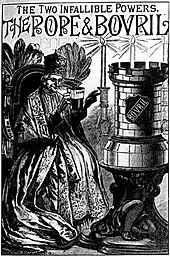 "The Two Infallible Powers: The Pope & Bovril"; poster for Bovril, c. 1900
"The Two Infallible Powers: The Pope & Bovril"; poster for Bovril, c. 1900 -
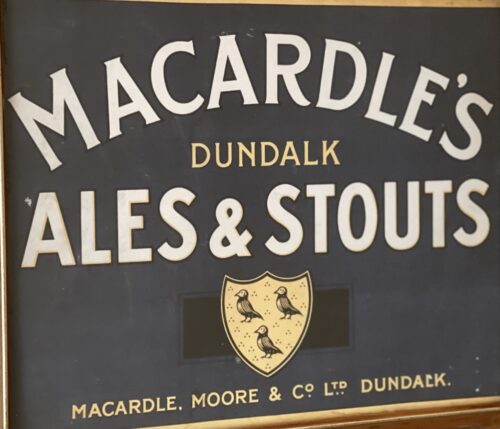
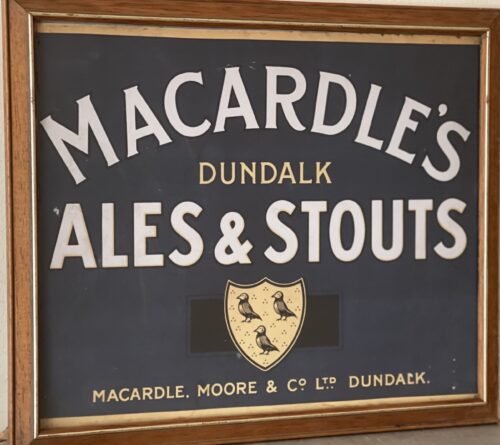 40cm x 34cm Limerick MacArdle Moore Brewery was a brewery in Dundalk, Ireland, formed in 1850 from the merger of two older breweries, McAllisters and Wynnes. Over the years it was to become almost synonymous with brewing in Dundalk. It joined the Guinness empire in the late 1960s. It gave its name to MacArdle's Traditional Ale, an Irish red ale, which is still produced by Diageo, at their St. James's Gate facility in Dublin. It was announced in 2000 that the brewery and a packing facility on the site were to be closed.Brewing resumed on the site by the beverages division of Alltech in 2018, with the move of their brewing from Newry
40cm x 34cm Limerick MacArdle Moore Brewery was a brewery in Dundalk, Ireland, formed in 1850 from the merger of two older breweries, McAllisters and Wynnes. Over the years it was to become almost synonymous with brewing in Dundalk. It joined the Guinness empire in the late 1960s. It gave its name to MacArdle's Traditional Ale, an Irish red ale, which is still produced by Diageo, at their St. James's Gate facility in Dublin. It was announced in 2000 that the brewery and a packing facility on the site were to be closed.Brewing resumed on the site by the beverages division of Alltech in 2018, with the move of their brewing from Newry -

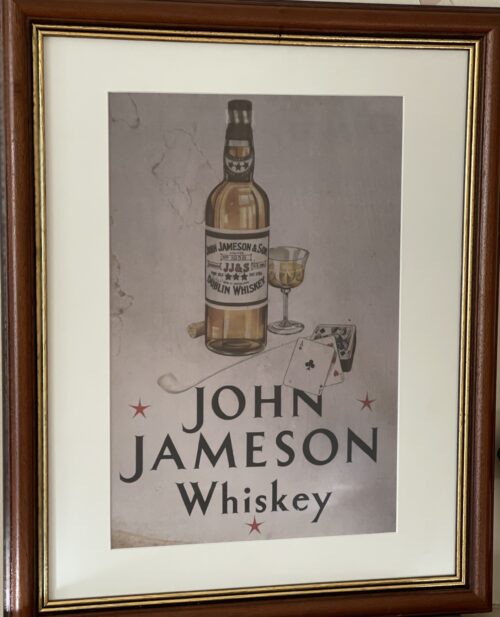 60cm x 50cm Limerick John Jameson was originally a lawyer from Alloa in Scotland before he founded his eponymous distillery in Dublin in 1780.Prevoius to this he had made the wise move of marrying Margaret Haig (1753–1815) in 1768,one of the simple reasons being Margaret was the eldest daughter of John Haig, the famous whisky distiller in Scotland. John and Margaret had eight sons and eight daughters, a family of 16 children. Portraits of the couple by Sir Henry Raeburn are on display in the National Gallery of Ireland. John Jameson joined the Convivial Lodge No. 202, of the Dublin Freemasons on the 24th June 1774 and in 1780, Irish whiskey distillation began at Bow Street. In 1805, he was joined by his son John Jameson II who took over the family business that year and for the next 41 years, John Jameson II built up the business before handing over to his son John Jameson the 3rd in 1851. In 1901, the Company was formally incorporated as John Jameson and Son Ltd. Four of John Jameson’s sons followed his footsteps in distilling in Ireland, John Jameson II (1773 – 1851) at Bow Street, William and James Jameson at Marrowbone Lane in Dublin (where they partnered their Stein relations, calling their business Jameson and Stein, before settling on William Jameson & Co.). The fourth of Jameson's sons, Andrew, who had a small distillery at Enniscorthy, Co. Wexford, was the grandfather of Guglielmo Marconi, inventor of wireless telegraphy. Marconi’s mother was Annie Jameson, Andrew’s daughter. John Jameson’s eldest son, Robert took over his father’s legal business in Alloa. The Jamesons became the most important distilling family in Ireland, despite rivalry between the Bow Street and Marrowbone Lane distilleries. By the turn of the 19th century, it was the second largest producer in Ireland and one of the largest in the world, producing 1,000,000 gallons annually. Dublin at the time was the centre of world whiskey production. It was the second most popular spirit in the world after rum and internationally Jameson had by 1805 become the world's number one whiskey. Today, Jameson is the world's third largest single-distillery whiskey. Historical events, for a time, set the company back. The temperance movement in Ireland had an enormous impact domestically but the two key events that affected Jameson were the Irish War of Independence and subsequent trade war with the British which denied Jameson the export markets of the Commonwealth, and shortly thereafter, the introduction of prohibition in the United States. While Scottish brands could easily slip across the Canada–US border, Jameson was excluded from its biggest market for many years. The introduction of column stills by the Scottish blenders in the mid-19th-century enabled increased production that the Irish, still making labour-intensive single pot still whiskey, could not compete with. There was a legal enquiry somewhere in 1908 to deal with the trade definition of whiskey. The Scottish producers won within some jurisdictions, and blends became recognised in the law of that jurisdiction as whiskey. The Irish in general, and Jameson in particular, continued with the traditional pot still production process for many years.In 1966 John Jameson merged with Cork Distillers and John Powers to form the Irish Distillers Group. In 1976, the Dublin whiskey distilleries of Jameson in Bow Street and in John's Lane were closed following the opening of a New Midleton Distillery by Irish Distillers outside Cork. The Midleton Distillery now produces much of the Irish whiskey sold in Ireland under the Jameson, Midleton, Powers, Redbreast, Spot and Paddy labels. The new facility adjoins the Old Midleton Distillery, the original home of the Paddy label, which is now home to the Jameson Experience Visitor Centre and the Irish Whiskey Academy. The Jameson brand was acquired by the French drinks conglomerate Pernod Ricard in 1988, when it bought Irish Distillers. The old Jameson Distillery in Bow Street near Smithfield in Dublin now serves as a museum which offers tours and tastings. The distillery, which is historical in nature and no longer produces whiskey on site, went through a $12.6 million renovation that was concluded in March 2016, and is now a focal part of Ireland's strategy to raise the number of whiskey tourists, which stood at 600,000 in 2017.Bow Street also now has a fully functioning Maturation Warehouse within its walls since the 2016 renovation. It is here that Jameson 18 Bow Street is finished before being bottled at Cask Strength. In 2008, The Local, an Irish pub in Minneapolis, sold 671 cases of Jameson (22 bottles a day),making it the largest server of Jameson's in the world – a title it maintained for four consecutive years.
60cm x 50cm Limerick John Jameson was originally a lawyer from Alloa in Scotland before he founded his eponymous distillery in Dublin in 1780.Prevoius to this he had made the wise move of marrying Margaret Haig (1753–1815) in 1768,one of the simple reasons being Margaret was the eldest daughter of John Haig, the famous whisky distiller in Scotland. John and Margaret had eight sons and eight daughters, a family of 16 children. Portraits of the couple by Sir Henry Raeburn are on display in the National Gallery of Ireland. John Jameson joined the Convivial Lodge No. 202, of the Dublin Freemasons on the 24th June 1774 and in 1780, Irish whiskey distillation began at Bow Street. In 1805, he was joined by his son John Jameson II who took over the family business that year and for the next 41 years, John Jameson II built up the business before handing over to his son John Jameson the 3rd in 1851. In 1901, the Company was formally incorporated as John Jameson and Son Ltd. Four of John Jameson’s sons followed his footsteps in distilling in Ireland, John Jameson II (1773 – 1851) at Bow Street, William and James Jameson at Marrowbone Lane in Dublin (where they partnered their Stein relations, calling their business Jameson and Stein, before settling on William Jameson & Co.). The fourth of Jameson's sons, Andrew, who had a small distillery at Enniscorthy, Co. Wexford, was the grandfather of Guglielmo Marconi, inventor of wireless telegraphy. Marconi’s mother was Annie Jameson, Andrew’s daughter. John Jameson’s eldest son, Robert took over his father’s legal business in Alloa. The Jamesons became the most important distilling family in Ireland, despite rivalry between the Bow Street and Marrowbone Lane distilleries. By the turn of the 19th century, it was the second largest producer in Ireland and one of the largest in the world, producing 1,000,000 gallons annually. Dublin at the time was the centre of world whiskey production. It was the second most popular spirit in the world after rum and internationally Jameson had by 1805 become the world's number one whiskey. Today, Jameson is the world's third largest single-distillery whiskey. Historical events, for a time, set the company back. The temperance movement in Ireland had an enormous impact domestically but the two key events that affected Jameson were the Irish War of Independence and subsequent trade war with the British which denied Jameson the export markets of the Commonwealth, and shortly thereafter, the introduction of prohibition in the United States. While Scottish brands could easily slip across the Canada–US border, Jameson was excluded from its biggest market for many years. The introduction of column stills by the Scottish blenders in the mid-19th-century enabled increased production that the Irish, still making labour-intensive single pot still whiskey, could not compete with. There was a legal enquiry somewhere in 1908 to deal with the trade definition of whiskey. The Scottish producers won within some jurisdictions, and blends became recognised in the law of that jurisdiction as whiskey. The Irish in general, and Jameson in particular, continued with the traditional pot still production process for many years.In 1966 John Jameson merged with Cork Distillers and John Powers to form the Irish Distillers Group. In 1976, the Dublin whiskey distilleries of Jameson in Bow Street and in John's Lane were closed following the opening of a New Midleton Distillery by Irish Distillers outside Cork. The Midleton Distillery now produces much of the Irish whiskey sold in Ireland under the Jameson, Midleton, Powers, Redbreast, Spot and Paddy labels. The new facility adjoins the Old Midleton Distillery, the original home of the Paddy label, which is now home to the Jameson Experience Visitor Centre and the Irish Whiskey Academy. The Jameson brand was acquired by the French drinks conglomerate Pernod Ricard in 1988, when it bought Irish Distillers. The old Jameson Distillery in Bow Street near Smithfield in Dublin now serves as a museum which offers tours and tastings. The distillery, which is historical in nature and no longer produces whiskey on site, went through a $12.6 million renovation that was concluded in March 2016, and is now a focal part of Ireland's strategy to raise the number of whiskey tourists, which stood at 600,000 in 2017.Bow Street also now has a fully functioning Maturation Warehouse within its walls since the 2016 renovation. It is here that Jameson 18 Bow Street is finished before being bottled at Cask Strength. In 2008, The Local, an Irish pub in Minneapolis, sold 671 cases of Jameson (22 bottles a day),making it the largest server of Jameson's in the world – a title it maintained for four consecutive years. -

 60cm x 50cm Limerick
60cm x 50cm Limerick
Paddy is a brand of blended Irish whiskey produced by Irish Distillers, at the Midleton distillery in County Cork, on behalf of Sazerac, a privately held American company. Irish distillers owned the brand until its sale to Sazerac in 2016. As of 2016, Paddy is the fourth largest selling Irish whiskey in the WorldHistory The Cork Distilleries Company was founded in 1867 to merge four existing distilleries in Cork city (the North Mall, the Green, Watercourse Road, and Daly's) under the control of one group.A fifth distillery, the Midleton distillery, joined the group soon after in 1868. In 1882, the company hired a young Corkman called Paddy Flaherty as a salesman. Flaherty travelled the pubs of Cork marketing the company's unwieldy named "Cork Distilleries Company Old Irish Whiskey".His sales techniques (which including free rounds of drinks for customers) were so good, that when publicans ran low on stock they would write the distillery to reorder cases of "Paddy Flaherty's whiskey". In 1912, with his name having become synonymous with the whiskey, the distillery officially renamed the whiskey Paddy Irish Whiskey in his honour. In 1920s and 1930s in Ireland, whiskey was sold in casks from the distillery to wholesalers, who would in turn sell it on to publicans.To prevent fluctuations in quality due to middlemen diluting their casks, Cork Distilleries Company decided to bottle their own whiskey known as Paddy, becoming one of the first to do so. In 1988, following an unsolicited takeover offer by Grand Metropolitan, Irish Distillers approached Pernod Ricard and subsequently became a subsidiary of the French drinks conglomerate, following a friendly takeover bid. In 2016, Pernod Ricard sold the Paddy brand to Sazerac, a privately held American firm for an undisclosed fee. Pernod Ricard stated that the sale was in order "simplify" their portfolio, and allow for more targeted investment in their other Irish whiskey brands, such as Jameson and Powers. At the time of the sale, Paddy was the fourth largest selling Irish whiskey brand in the world, with sales of 200,000 9-litre cases per annum, across 28 countries worldwide. Paddy whiskey is distilled three times and matured in oak casks for up to seven years.Compared with other Irish whiskeys, Paddy has a comparatively low pot still content and a high malt content in its blend. Jim Murray, author of the Whiskey bible, has rated Paddy as "one of the softest of all Ireland's whiskeys".

Introduced 1879, renamed as Paddy in 1912 -

 47cm x 37cm Limerick
47cm x 37cm LimerickBass,the former beer of choice of An Taoiseach Bertie Ahern,the Bass Ireland Brewery operated on the Glen Road in West Belfast for 107 years until its closure in 2004.But despite its popularity, this ale would be the cause of bitter controversy in the 1930s as you can learn below.
Founded in 1777 by William Bass in Burton-upon-Trent, Staffordshire, England.The main brand was Bass Pale Ale, once the highest-selling beer in the UK.By 1877, Bass had become the largest brewery in the world, with an annual output of one million barrels.Its pale ale was exported throughout the British Empire, and the company's distinctive red triangle became the UK's first registered trade mark. In the early 1930s republicans in Dublin and elsewhere waged a campaign of intimidation against publicans who sold Bass ale, which involved violent tactics and grabbed headlines at home and further afield. This campaign occurred within a broader movement calling for the boycott of British goods in Ireland, spearheaded by the IRA. Bass was not alone a British product, but republicans took issue with Colonel John Gretton, who was chairman of the company and a Conservative politician in his day.In Britain,Ireland and the Second World War, Ian Woods notes that the republican newspaper An Phoblacht set the republican boycott of Bass in a broader context , noting that there should be “No British ales. No British sweets or chocolate. Shoulder to shoulder for a nationwide boycott of British goods. Fling back the challenge of the robber empire.”
In late 1932, Irish newspapers began to report on a sustained campaign against Bass ale, which was not strictly confined to Dublin. On December 5th 1932, The Irish Times asked:
Will there be free beer in the Irish Free State at the end of this week? The question is prompted by the orders that are said to have been given to publicans in Dublin towards the end of last week not to sell Bass after a specified date.
The paper went on to claim that men visited Dublin pubs and told publicans “to remove display cards advertising Bass, to dispose of their stock within a week, and not to order any more of this ale, explaining that their instructions were given in furtherance of the campaign to boycott British goods.” The paper proclaimed a ‘War on English Beer’ in its headline. The same routine, of men visiting and threatening public houses, was reported to have happened in Cork.
It was later reported that on November 25th young men had broken into the stores owned by Bass at Moore Lane and attempted to do damage to Bass property. When put before the courts, it was reported that the republicans claimed that “Colonel Gretton, the chairman of the company, was a bitter enemy of the Irish people” and that he “availed himself of every opportunity to vent his hate, and was an ardent supporter of the campaign of murder and pillage pursued by the Black and Tans.” Remarkably, there were cheers in court as the men were found not guilty, and it was noted that they had no intention of stealing from Bass, and the damage done to the premises amounted to less than £5.
A campaign of intimidation carried into January 1933, when pubs who were not following the boycott had their signs tarred, and several glass signs advertising the ale were smashed across the city. ‘BOYCOTT BRITISH GOODS’ was painted across several Bass advertisements in the city.
Throughout 1933, there were numerous examples of republicans entering pubs and smashing the supply of Bass bottles behind the counter. This activity was not confined to Dublin,as this report from late August shows. It was noted that the men publicly stated that they belonged to the IRA.
September appears to have been a particularly active period in the boycott, with Brian Hanley identifying Dublin, Tralee, Naas, Drogheda and Waterford among the places were publicans were targetted in his study The IRA: 1926-1936. One of the most interesting incidents occurring in Dun Laoghaire. There, newspapers reported that on September 4th 1933 “more than fifty young men marched through the streets” before raiding the premises of Michael Moynihan, a local publican. Bottles of Bass were flung onto the roadway and advertisements destroyed. Five young men were apprehended for their role in the disturbances, and a series of court cases nationwide would insure that the Bass boycott was one of the big stories of September 1933.
The young men arrested in Dun Laoghaire refused to give their name or any information to the police, and on September 8th events at the Dublin District Court led to police baton charging crowds. The Irish Times reported that about fifty supporters of the young men gathered outside the court with placards such as ‘Irish Goods for Irish People’, and inside the court a cry of ‘Up The Republic!’ led to the judge slamming the young men, who told him they did not recognise his court. The night before had seen some anti-Bass activity in the city, with the smashing of Bass signs at Burgh Quay. This came after attacks on pubs at Lincoln Place and Chancery Street. It wasn’t long before Mountjoy and other prisons began to home some of those involved in the Boycott Bass campaign, which the state was by now eager to suppress.

An undated image of a demonstration to boycott British goods. Credit: http://irishmemory.blogspot.ie/
This dramatic court appearance was followed by similar scenes in Kilmainham, where twelve men were brought before the courts for a raid on the Dead Man’s Pub, near to Palmerstown in West Dublin. Almost all in their 20s, these men mostly gave addresses in Clondalkin. Their court case was interesting as charges of kidnapping were put forward, as Michael Murray claimed the men had driven him to the Featherbed mountain. By this stage, other Bass prisoners had begun a hungerstrike, and while a lack of evidence allowed the men to go free, heavy fines were handed out to an individual who the judge was certain had been involved.
The decision to go on hungerstrike brought considerable attention on prisoners in Mountjoy, and Maud Gonne MacBride spoke to the media on their behalf, telling the Irish Press on September 18th that political treatment was sought by the men. This strike had begun over a week previously on the 10th, and by the 18th it was understood that nine young men were involved. Yet by late September, it was evident the campaign was slowing down, particularly in Dublin.
The controversy around the boycott Bass campaign featured in Dáil debates on several occasions. In late September Eamonn O’Neill T.D noted that he believed such attacks were being allowed to be carried out “with a certain sort of connivance from the Government opposite”, saying:
I suppose the Minister is aware that this campaign against Bass, the destruction of full bottles of Bass, the destruction of Bass signs and the disfigurement of premises which Messrs. Bass hold has been proclaimed by certain bodies to be a national campaign in furtherance of the “Boycott British Goods” policy. I put it to the Minister that the compensation charges in respect of such claims should be made a national charge as it is proclaimed to be a national campaign and should not be placed on the overburdened taxpayers in the towns in which these terrible outrages are allowed to take place with a certain sort of connivance from the Government opposite.
Another contribution in the Dáil worth quoting came from Daniel Morrissey T.D, perhaps a Smithwicks man, who felt it necessary to say that we were producing “an ale that can compare favourably with any ale produced elsewhere” while condemning the actions of those targeting publicans:
I want to say that so far as I am concerned I have no brief good, bad, or indifferent, for Bass’s ale. We are producing in this country at the moment—and I am stating this quite frankly as one who has a little experience of it—an ale that can compare favourably with any ale produced elsewhere. But let us be quite clear that if we are going to have tariffs or embargoes, no tariffs or embargoes can be issued or given effect to in this country by any person, any group of persons, or any organisation other than the Government elected by the people of the country.
Tim Pat Coogan claims in his history of the IRA that this boycott brought the republican movement into conflict with the Army Comrades Association, later popularly known as the ‘Blueshirts’. He claims that following attacks in Dublin in December 1932, “the Dublin vitners appealed to the ACA for protection and shipments of Bass were guarded by bodyguards of ACA without further incident.” Yet it is undeniable there were many incidents of intimidation against suppliers and deliverers of the product into 1933.
Not all republicans believed the ‘Boycott Bass’ campaign had been worthwhile. Patrick Byrne, who would later become secretary within the Republican Congress group, later wrote that this was a time when there were seemingly bigger issues, like mass unemployment and labour disputes in Belfast, yet:
In this situation, while the revolution was being served up on a plate in Belfast, what was the IRA leadership doing? Organising a ‘Boycott Bass’ Campaign. Because of some disparaging remarks the Bass boss, Colonel Gretton, was reported to have made about the Irish, some IRA leaders took umbrage and sent units out onto the streets of Dublin and elsewhere to raid pubs, terrify the customers, and destroy perfectly good stocks of bottled Bass, an activity in which I regret to say I was engaged.
Historian Brian Hanley has noted by late 1933 “there was little effort to boycott anything except Bass and the desperation of the IRA in hoping violence would revive the campaign was in fact an admission of its failure. At the 1934 convention the campaign was quietly abandoned.”
Interestingly, this wasn’t the last time republicans would threaten Bass. In 1986 The Irish Times reported that Bass and Guinness were both threatened on the basis that they were supplying to British Army bases and RUC stations, on the basis of providing a service to security forces.
-

 47cm x 37cm LimerickFor much of the last century, and indeed for well over half of the present one, Limerick's importance was directly attributed to her three well-known bacon factories, namely, J. Matterson & Sons, Roches Street, established in 1816 by Mr. John Russell, a Cumberland man in conjunction with Mr. Matterson, using the method of curing then current in Berwick-on-Tweed. W.J. Shaw & Sons, founded in the year 1831 at Mulgrave Street by William John Shaw, a descendant of a County Down family, and O'Mara's bacon factory, Roches Street, which had its origin in Mungret Street some few years before 1839, when James O'Mara from Toomevara started curing bacon in the basement of his house there. Apparently, this basement business flourished, for in 1839 he moved to Roches Street to the premises it occupies today.About the middle of the last century, for some reason now difficult to fathom, Limerick bacon and especially Limerick hams, became well known for their excellent flavour throughout the English-speaking world. It is on record that Glasgow curers in an effort to produce hams equal in excellence to those of Limerick, imported Limerick workmen who were supposed to know all about the way in which the meat was turned out at home. Apparently, they did not bring secrets with them for their efforts were unsuccessful, There were also much larger bacon factories in parts of the British Isles; for instance, Belfast is reputed to have exported four times the number of hams produced in Limerick, and places like Glasgow and Liverpool had several factories producing very large quantities of bacon as well. None of them, however, quite matched' those produced in the three local factories for flavour and taste. O’MARA’S, MATTERSON’S, SHAW’S and Denny’s were the names that made Limerick famous for its bacon produce for 180 years – earning it the nickname ‘Pigstown’. The reputation of Limerick ham, the food culture that arose from a plentiful supply of cheap products, the story of the pork butchers, the pig buyers, the sounds of the city with factory horns signalling the call to work – all of these still resonate in Limerick in the memories of its citizens and former workers. A definitive account of this industry that operated at the centre of the city, supplied by the farms of rural county Limerick for over 180 years will be documented in a new book called Pigtown – A History of Limerick’s Bacon Industry. Ruth Guiry was commissioned to undertake the research under the guidance of Dr Maura Cronin from Mary Immaculate College and one of the 27 people she interviewed to understand the role the bacon factories had in Limerick was Joe Hayes. Joe Hayes started working in a bacon factory in 1962, aged 16 years old. He worked with his dad, and later on with his two sons until the factory closed in 1986. “When the factory closed, a group of us got our own little unit, we rented it, and produced our own sausages, puddings and things.” It was a huge part of Limerick’s social scene: four generations of Joe’s family worked in bacon factories, with uncles, sisters, brothers, sons and cousins all working in the factory at one time or another: “If one factory was caic, you wouldn’t have a problem getting a job in the other one. And he doesn’t mince his word when talking about the work they did. “They brought the pigs in, we killed the pigs, and prepared the bacon: that’s the way it was in the bacon factories.” When asked about if there were ever animal cruelty protests, he laughs at the idea.
47cm x 37cm LimerickFor much of the last century, and indeed for well over half of the present one, Limerick's importance was directly attributed to her three well-known bacon factories, namely, J. Matterson & Sons, Roches Street, established in 1816 by Mr. John Russell, a Cumberland man in conjunction with Mr. Matterson, using the method of curing then current in Berwick-on-Tweed. W.J. Shaw & Sons, founded in the year 1831 at Mulgrave Street by William John Shaw, a descendant of a County Down family, and O'Mara's bacon factory, Roches Street, which had its origin in Mungret Street some few years before 1839, when James O'Mara from Toomevara started curing bacon in the basement of his house there. Apparently, this basement business flourished, for in 1839 he moved to Roches Street to the premises it occupies today.About the middle of the last century, for some reason now difficult to fathom, Limerick bacon and especially Limerick hams, became well known for their excellent flavour throughout the English-speaking world. It is on record that Glasgow curers in an effort to produce hams equal in excellence to those of Limerick, imported Limerick workmen who were supposed to know all about the way in which the meat was turned out at home. Apparently, they did not bring secrets with them for their efforts were unsuccessful, There were also much larger bacon factories in parts of the British Isles; for instance, Belfast is reputed to have exported four times the number of hams produced in Limerick, and places like Glasgow and Liverpool had several factories producing very large quantities of bacon as well. None of them, however, quite matched' those produced in the three local factories for flavour and taste. O’MARA’S, MATTERSON’S, SHAW’S and Denny’s were the names that made Limerick famous for its bacon produce for 180 years – earning it the nickname ‘Pigstown’. The reputation of Limerick ham, the food culture that arose from a plentiful supply of cheap products, the story of the pork butchers, the pig buyers, the sounds of the city with factory horns signalling the call to work – all of these still resonate in Limerick in the memories of its citizens and former workers. A definitive account of this industry that operated at the centre of the city, supplied by the farms of rural county Limerick for over 180 years will be documented in a new book called Pigtown – A History of Limerick’s Bacon Industry. Ruth Guiry was commissioned to undertake the research under the guidance of Dr Maura Cronin from Mary Immaculate College and one of the 27 people she interviewed to understand the role the bacon factories had in Limerick was Joe Hayes. Joe Hayes started working in a bacon factory in 1962, aged 16 years old. He worked with his dad, and later on with his two sons until the factory closed in 1986. “When the factory closed, a group of us got our own little unit, we rented it, and produced our own sausages, puddings and things.” It was a huge part of Limerick’s social scene: four generations of Joe’s family worked in bacon factories, with uncles, sisters, brothers, sons and cousins all working in the factory at one time or another: “If one factory was caic, you wouldn’t have a problem getting a job in the other one. And he doesn’t mince his word when talking about the work they did. “They brought the pigs in, we killed the pigs, and prepared the bacon: that’s the way it was in the bacon factories.” When asked about if there were ever animal cruelty protests, he laughs at the idea.
They started at 8am and finished at 5.30 working a 40 hour week when the factory closed in 1986, but despite their work, the people who worked in factories often couldn’t afford to buy the expensive cuts of meat. After the expensive cuts were prepared, the offal, the spare ribs, the pigs’ heads would go to the poorer people. “The blood was used to make the pudding, the packet, the tripe was made off the belly. Everything was used off the pig, and it fed Limerick city.” It was a way of life down in Limerick, so when the factories closed, thousands of people working in a bacon factories were out of jobs, and thousands of families were affected. But it wasn’t the competition from big supermarkets that did it – it was free trade. The Danes, the French, the Dutch all started exporting their products here, and Limerick factories didn’t have the money to export to compete. “Michael O’Mara’s funeral was this week – he was the last of the bacon factory managers.” says Joe. “After the Limerick factory closed, he tried doing different bits and pieces, but nothing worked out for him, so he worked in a factory for a couple of years before retiring.” Joe Hayes himself is retired now, and when he buys his meat he gets it in a supermarket. “Meat is meat,” he says.”But if I see the tricolour flag, I’ll still buy it even if it’s dearer.” Pigtown - A History of Limerick’s Bacon Industry by Ruth Guiry is co-edited by Dr Maura Cronin and Jacqui Hayes.People still eat sausages and bacon – where do they think they come from?














